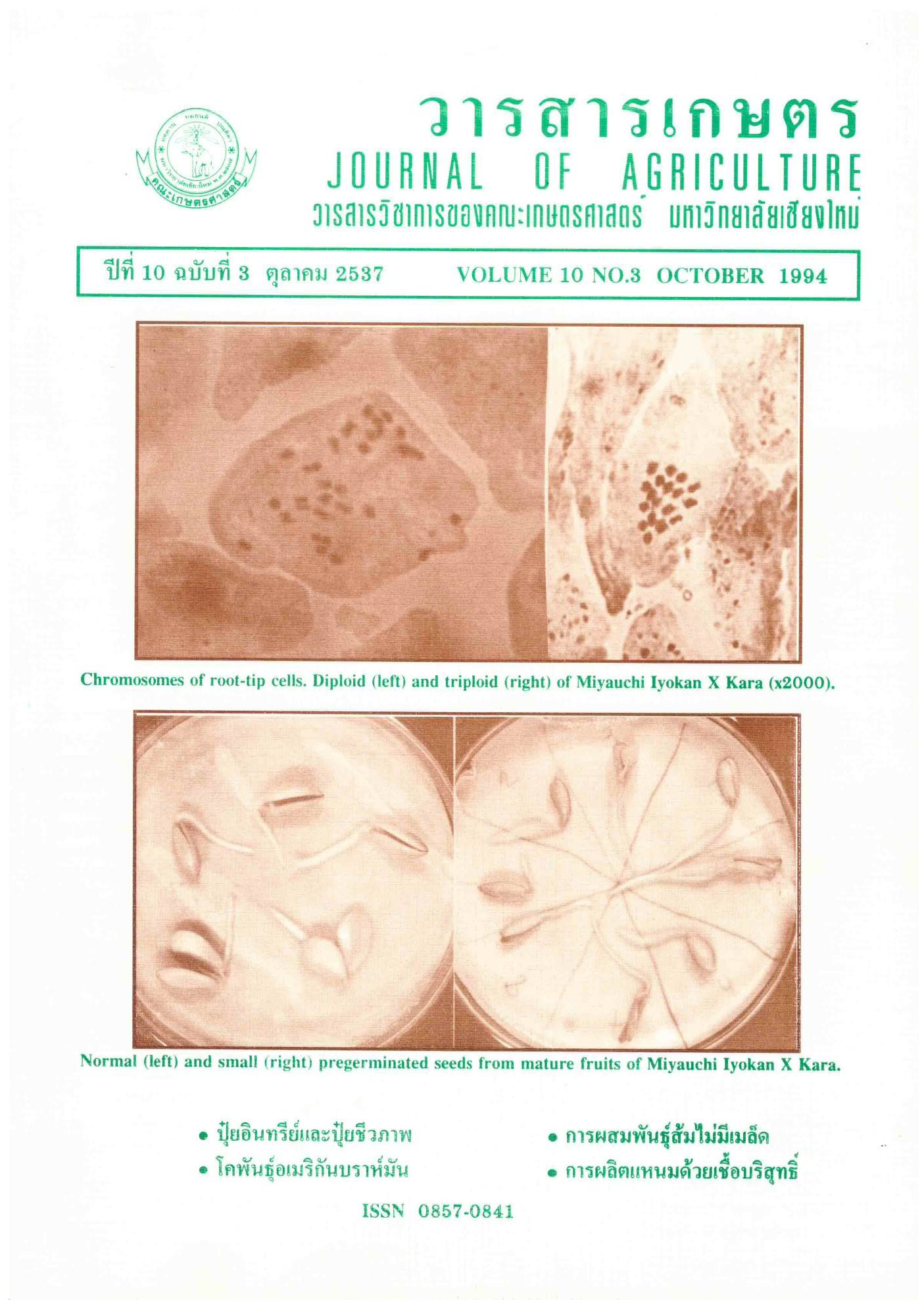การใช้สารเคมีที่ให้ความเป็นกรดร่วมกับเชื้อบริสุทธิ์เริ่มต้นผสมในผลิตภัณฑ์แหนม
Main Article Content
บทคัดย่อ
สารเคมีที่ให้ความเป็นกรด 2 ชนิด คือ กลูโคโนเดลตาแลคโตน (GDL) และกรดแลคติคที่ระดับความเข้มข้นร้อยละ 0.25 ถูกนำมาใช้ในสูตรการผลิตผลิตภัณฑ์แหนมโดยใช้ร่วมกับเชื้อบริสุทธิ์เริ่มต้นผสม 3 สายพันธุ์ คือ Lactobacillus plantarum (NHI 1100), Pediococcus cerevisiae (NZ DRI) และ Micrococcus varians (ATCC 15306) เปรียบเทียบกับชุดควบคุม ซึ่งหลังจากการหมักเป็นเวลา 48 ชั่วโมง พบว่า การใช้กรดแลคติคจะช่วยลดเชื้อจุลินทรีย์พวก Enterobacteriaceae ลงได้มากที่สุด ถัดมาคือการใช้ GDL และชุดควบคุมตามลำดับ จากผลการทดลองแสดงให้เห็นว่าไม่มีความแตกต่างในด้านค่าความเป็นกรดด่าง (pH) อย่างมีนัยสำคัญทางสถิติที่ p>0.05 นอกจากนี้ยังพบว่ามีปริมาณสารไนไตรท์ที่เหลือ (Residual nitrite) เพียง 3-4 ppm (กฎหมายกำหนดไว้ไม่เกิน 200 ppm) แต่การใช้กรดแลคติคจะทำให้ลักษณะเนื้อค่อนข้างนิ่มและมีค่าแรงกด (Compression force) ต่ำกว่าการใช้ GDL และชุดควบคุม อย่างไรก็ตามผลิตภัณฑ์ที่ใช้ GDL ได้รับการยอมรับจากผู้บริโภคสูงที่สุด และผลิตภัณฑ์ที่ใช้กรดแลคติคมีการยอมรับต่ำที่สุด แต่ไม่มีความแตกต่างอย่างมีนัยสำคัญทางสถิติที่ p>0.05 นอกจากนี้ยังพบว่าสารเคมีที่ให้ความเป็นกรดมีผลกระทบต่อคุณภาพของผลิตภัณฑ์แหนมมากกว่าการใช้เชื้อบริสุทธิ์เริ่มต้นผสม
Article Details
เอกสารอ้างอิง
สุธยา บุญถนอม. 2537. การใช้สารเคมีที่ให้ความเป็นกรดและหัวเชื้อผสมในผลิตภัณฑ์แหนม. วิทยานิพนธ์ปริญญามหาบัณฑิต จุฬาลงกรณ์มหาวิทยาลัย.
อดิศร เสวตวิวัฒน์. 2533. ผลของการใช้กล้าเชื้อแบคทีเรียแลคติคต่อซาลโมเนลลาในการหมักแหนม. วิทยานิพนธ์ปริญญามหาบัณฑิต มหาวิทยาลัยเกษตรศาสตร์.
AOAC. 1984. Official Methods of Analysis. (13rd ed.) Association of Official Analytical Chemists, Washington D.C.
Bacus, J. N. 1984. Utilization of Microorganisms in Meat Processing. Research Studies Press, Ltd., England.
Barber, L. E., and Deibel, R. H. 1972. Effect of pH and oxygen tension on staphylococci growth and enterotoxin formation in fermented sausage. Appl. Microbiol. 25: 891. Biolgy. 25: 891.
Daly, C., Chance, M. L, Sandine, W. E. and Elliker, P. D R. 1973. Control of Staphylococcus aureus in sausage by starter cultures and chemical acidu CURSO lation. J. Food Sci. 38: 426.
Klettner, P. G., and Baumgartner, P. A. 1980. The technology of raw dry sausage manufacture. Food Technol, in Australia, 32: 380.
Kiss, I. 1984. Testing Methods in Food Microbiology. Elsevier, Amsterdam-Oxford.
Kotter, L. Palitzsch, A. and Geiger, G. 1969. The use of glucono-delta-lactone in the manufacture of sausage products. FSTA. 1:78.
Maijala, R. L., Eerola, S. H., Aho, M.A., and Hirn, J. A. 1993. The effect of GDL-induced pH decrease on the formation of biogenic amines in meat. J. Food Prot. 56: 125.
Riemann, H., Lee, W. H., and Genigeorgis, C. 1972. Control of Clostridium botulinum and Staphylococcus aureus in semi-preserved meat products. J. Milk Food Technol. 35: 514.
Shank, J. L., Silliker, J.H., and Harper, R. H. 1962. The effect of nitric oxide on bacteria. Appl. Microbiol. 10: 185.
Walonic, D. S. 1987. Stat-Packets. Walonick Associates Inc., Minneapolis, MN.
Wiriyacharee, P. 1990. The systemetic development of a controlled fermentation process using mixed bacterial starter cultures for Nham, a Thai semi-dry sausage. In Doctoral dissertation, Massey University.


